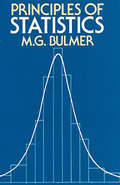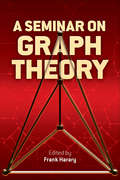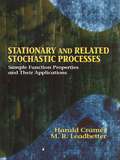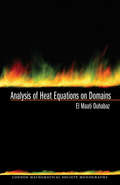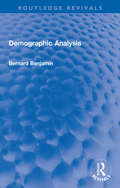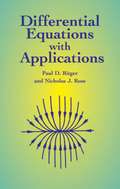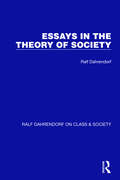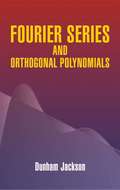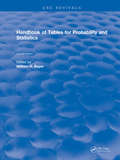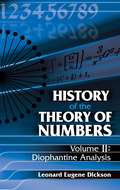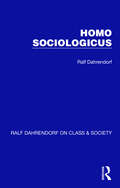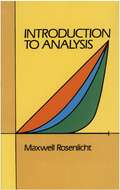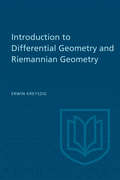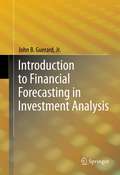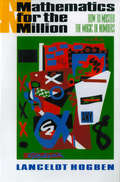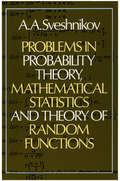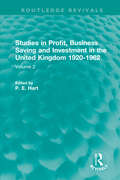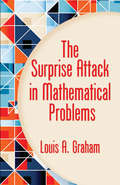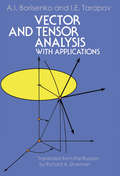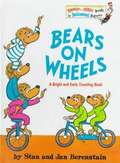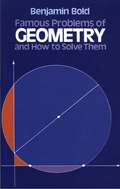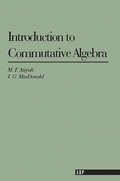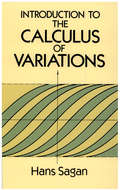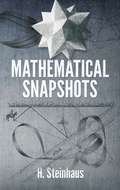- Table View
- List View
Principles of Statistics
by M. G. BulmerThere are many textbooks which describe current methods of statistical analysis, while neglecting related theory. There are equally many advanced textbooks which delve into the far reaches of statistical theory, while bypassing practical applications. But between these two approaches is an unfilled gap, in which theory and practice merge at an intermediate level. Professor M. G. Bulmer's Principles of Statistics, originally published in 1965, was created to fill that need. The new, corrected Dover edition of Principles of Statistics makes this invaluable mid-level text available once again for the classroom or for self-study. Principles of Statistics was created primarily for the student of natural sciences, the social scientist, the undergraduate mathematics student, or anyone familiar with the basics of mathematical language. It assumes no previous knowledge of statistics or probability; nor is extensive mathematical knowledge necessary beyond a familiarity with the fundamentals of differential and integral calculus. (The calculus is used primarily for ease of notation; skill in the techniques of integration is not necessary in order to understand the text.)Professor Bulmer devotes the first chapters to a concise, admirably clear description of basic terminology and fundamental statistical theory: abstract concepts of probability and their applications in dice games, Mendelian heredity, etc.; definitions and examples of discrete and continuous random variables; multivariate distributions and the descriptive tools used to delineate them; expected values; etc. The book then moves quickly to more advanced levels, as Professor Bulmer describes important distributions (binomial, Poisson, exponential, normal, etc.), tests of significance, statistical inference, point estimation, regression, and correlation. Dozens of exercises and problems appear at the end of various chapters, with answers provided at the back of the book. Also included are a number of statistical tables and selected references.
A Seminar on Graph Theory (Dover Books on Mathematics)
by Frank HararyPresented in 1962–63 by experts at University College, London, these lectures offer a variety of perspectives on graph theory. Although the opening chapters form a coherent body of graph theoretic concepts, this volume is not a text on the subject but rather an introduction to the extensive literature of graph theory. The seminar's topics are geared toward advanced undergraduate students of mathematics.Lectures by this volume's editor, Frank Harary, include "Some Theorems and Concepts of Graph Theory," "Topological Concepts in Graph Theory," "Graphical Reconstruction," and other introductory talks. A series of invited lectures follows, featuring presentations by other authorities on the faculty of University College as well as visiting scholars. These include "Extremal Problems in Graph Theory" by Paul Erdös, "Complete Bipartite Graphs: Decomposition into Planar Subgraphs," by Lowell W. Beineke, "Graphs and Composite Games," by Cedric A. B. Smith, and several others.
Stationary and Related Stochastic Processes: Sample Function Properties and Their Applications
by M. Ross Leadbetter Harald CramérThis graduate-level text offers a comprehensive account of the general theory of stationary processes, with special emphasis on the properties of sample functions. Assuming a familiarity with the basic features of modern probability theory, the text develops the foundations of the general theory of stochastic processes, examines processes with a continuous-time parameter, and applies the general theory to procedures key to the study of stationary processes. Additional topics include analytic properties of the sample functions and the problem of time distribution of the intersections between a sample function. 1967 edition.
Analysis of Heat Equations on Domains. (LMS-31)
by El-Maati OuhabazThis is the first comprehensive reference published on heat equations associated with non self-adjoint uniformly elliptic operators. The author provides introductory materials for those unfamiliar with the underlying mathematics and background needed to understand the properties of heat equations. He then treats Lp properties of solutions to a wide class of heat equations that have been developed over the last fifteen years. These primarily concern the interplay of heat equations in functional analysis, spectral theory and mathematical physics.This book addresses new developments and applications of Gaussian upper bounds to spectral theory. In particular, it shows how such bounds can be used in order to prove Lp estimates for heat, Schrödinger, and wave type equations. A significant part of the results have been proved during the last decade.The book will appeal to researchers in applied mathematics and functional analysis, and to graduate students who require an introductory text to sesquilinear form techniques, semigroups generated by second order elliptic operators in divergence form, heat kernel bounds, and their applications. It will also be of value to mathematical physicists. The author supplies readers with several references for the few standard results that are stated without proofs.
Demographic Analysis (Routledge Revivals)
by Bernard BenjaminFirst published in 1968, Demographic Analysis was written to provide a comprehensive account of demographic methods for those with a need to understand population movements. The book provides an introduction to some of the key tools used by demographers and the principal sources of population data. Beginning with an overview of the scope, content and use of the population census, it then examines methods for measuring births, deaths, and migration before setting out the methodology for determining the contributions of these elements to population change and estimating past or future changes. The book also explores sickness as a population characteristic and a way of better understanding mortality variations.
Differential Equations With Applications
by Paul D. Ritger Nicholas J. RoseCoherent introductory text focuses on initial- and boundary-value problems, general properties of linear equations, and differences between linear and nonlinear systems. Answers to most problems.
Essays in the Theory of Society (Ralf Dahrendorf on Class & Society #2)
by Ralf DahrendorfOriginally published in 1968, these ten essays by one of Europe’s leading sociological theorists deal with important issues on the borderline between sociology and social philosophy and demonstrate the author’s deep insight into history and political analysis. The author maintains that the structures of power in which the political process takes place not only originate change and give it direction, but also produce the fertile conflicts that give expression to the fundamental uncertainty of human existence. Through an examination of various concepts inherent in this dynamic process – power, resistance, conflict, change, freedom, uncertainty – a coherent theory of society emerges.
Fourier Series and Orthogonal Polynomials: The Carus Mathematical Monographs, No. 6
by Dunham JacksonThis text for undergraduate and graduate students illustrates the fundamental simplicity of the properties of orthogonal functions and their developments in related series. Starting with a definition and explanation of the elements of Fourier series, the text follows with examinations of Legendre polynomials and Bessel functions. Boundary value problems consider Fourier series in conjunction with Laplace's equation in an infinite strip and in a rectangle, with a vibrating string, in three dimensions, in a sphere, and in other circumstances. An overview of Pearson frequency functions is followed by chapters on orthogonal, Jacobi, Hermite, and Laguerre polynomials, and the text concludes with a chapter on convergence. 1941 edition.
Handbook of Tables for Probability and Statistics
by William H. BeyerPracticing statisticians and scientists working in diverse fields need an authoritative reference handbook of statistical tables developed to "aid" in the investigation and solution of many of today's challenging problems. This book has been compiled and arranged to meet the needs of these users of statistics.
History of the Theory of Numbers, Volume II: Diophantine Analysis
by Leonard Eugene DicksonThe three-volume series History of the Theory of Numbers is the work of the distinguished mathematician Leonard Eugene Dickson, who taught at the University of Chicago for four decades and is celebrated for his many contributions to number theory and group theory. This second volume in the series, which is suitable for upper-level undergraduates and graduate students, is devoted to the subject of diophantine analysis. It can be read independently of the preceding volume, which explores divisibility and primality, and volume III, which examines quadratic and higher forms.Featured topics include polygonal, pyramidal, and figurate numbers; linear diophantine equations and congruences; partitions; rational right triangles; triangles, quadrilaterals, and tetrahedra; the sums of two, three, four, and n squares; the number of solutions of quadratic congruences in n unknowns; Liouville's series of eighteen articles; the Pell equation; squares in arithmetical or geometrical progression; equations of degrees three, four, and n; sets of integers with equal sums of like powers; Waring's problem and related results; Fermat's last theorem; and many other related subjects. Indexes of authors cited and subjects appear at the end of the book.
Homo Sociologicus (Ralf Dahrendorf on Class & Society #3)
by Ralf DahrendorfFirst published in English as part of the Essays in the Theory of Society, this volume reissues the stand-alone Homo Sociologicus for which the author wrote a new introduction when it was originally published in 1973. The controversial book deals with the history, significance and limits of the category of social role and discusses the dilemma posed by homo sociologicus. The author shows that for society and sociology, socialization invariably means depersonalization, the yielding up of man’s absolute individuality and liberty to the constraint and generality of social roles. This volume includes the essay, Sociology and Human Nature, written as a postscript to Homo Sociologicus.
Introduction to Analysis
by Maxwell RosenlichtWritten for junior and senior undergraduates, this remarkably clear and accessible treatment covers set theory, the real number system, metric spaces, continuous functions, Riemann integration, multiple integrals, and more. Rigorous and carefully presented, the text assumes a year of calculus and features problems at the end of each chapter. 1968 edition.
Introduction to Differential Geometry and Riemannian Geometry (Mathematical Expositions #16)
by Erwin KreyszigThis book provides an introduction to the differential geometry of curves and surfaces in three-dimensional Euclidean space and to n-dimensional Riemannian geometry. Based on Kreyszig's earlier book Differential Geometry, it is presented in a simple and understandable manner with many examples illustrating the ideas, methods, and results.<P><P> Among the topics covered are vector and tensor algebra, the theory of surfaces, the formulae of Weingarten and Gauss, geodesics, mappings of surfaces and their applications, and global problems. A thorough investigation of Reimannian manifolds is made, including the theory of hypersurfaces. <P> Interesting problems are provided and complete solutions are given at the end of the book together with a list of the more important formulae. Elementary calculus is the sole prerequisite for the understanding of this detailed and complete study in mathematics.
Introduction to Financial Forecasting in Investment Analysis
by John B. Guerard Jr.Forecasting--the art and science of predicting future outcomes--has become a crucial skill in business and economic analysis. This volume introduces the reader to the tools, methods, and techniques of forecasting, specifically as they apply to financial and investing decisions. With an emphasis on "earnings per share" (eps), the author presents a data-oriented text on financial forecasting, understanding financial data, assessing firm financial strategies (such as share buybacks and R&D spending), creating efficient portfolios, and hedging stock portfolios with financial futures. The opening chapters explain how to understand economic fluctuations and how the stock market leads the general economic trend; introduce the concept of portfolio construction and how movements in the economy influence stock price movements; and introduce the reader to the forecasting process, including exponential smoothing and time series model estimations. Subsequent chapters examine the composite index of leading economic indicators (LEI); review financial statement analysis and mean-variance efficient portfolios; and assess the effectiveness of analysts' earnings forecasts. Using data from such firms as Intel, General Electric, and Hitachi, Guerard demonstrates how forecasting tools can be applied to understand the business cycle, evaluate market risk, and demonstrate the impact of global stock selection modeling and portfolio construction.
Mathematics for the Million: How to Master the Magic of Numbers
by Lancelot Hogben"It makes alive the contents of the elements of mathematics."--Albert Einstein Taking only the most elementary knowledge for granted, Lancelot Hogben leads readers of this famous book through the whole course from simple arithmetic to calculus. His illuminating explanation is addressed to the person who wants to understand the place of mathematics in modern civilization but who has been intimidated by its supposed difficulty. Mathematics is the language of size, shape, and order--a language Hogben shows one can both master and enjoy.
Problems in Probability Theory, Mathematical Statistics and Theory of Random Functions
by A. A. SveshnikovProblem solving is the main thrust of this excellent, well-organized workbook. Suitable for students at all levels in probability theory and statistics, the book presents over 1,000 problems and their solutions, illustrating fundamental theory and representative applications in the following fields: Random Events; Distribution Laws; Correlation Theory; Random Variables; Entropy & Information; Markov Processes; Systems of Random Variables; Limit Theorems; Data Processing; and more.The coverage of topics is both broad and deep, ranging from the most elementary combinatorial problems through limit theorems and information theory. Each chapter introduction sets forth the basic formulas and a general outline of the theory necessary for the problems that follow. Next comes a group of sample problems and their solutions, worked out in detail, which serve as effective orientation for the exercises to come.The emphasis on problem solving and the multitude of problems presented make this book, translated from the Russian, a valuable reference manual for scientists, engineers, and computer specialists, as well as a comprehensive workbook for undergraduates in these fields.
Studies in Profit, Business Saving and Investment in the United Kingdom 1920-1962: Volume 2 (Routledge Revivals)
by P. E. HartOriginally published in 1968, this second volume of the Glasgow Studies in Profit, Business Saving and Investment uses the financial data assembled in Volume 1 to test economic theories of the factor distribution income, of the appropriation of profit, of the determinants of investment, and of the return on capital. The tests enabled the measurement of long-run and short-run variation of the ratio of profit to employee compensation in the United Kingdom at the level of individual industries and the whole industrial sector. As well as measuring the relationship between a company’s sales or profits and its expenditure on fixed assets, the book describes the long-term decline in the rate of return on capital in the UK and measures the effect of the intensity of competition on this return.
The Surprise Attack in Mathematical Problems
by Louis A. GrahamFor decades, professionals in applied mathematics and mathematical puzzle fans from all over the world supplied provocative problems to the puzzle columns of the Graham Dial. Upon the appearance of an interesting problem, readers wrote in to the Dial suggesting new approaches to the solution, some greatly simplifying the problem and others broadening its scope. This collection presents 52 of the finest problems, all featuring the "surprise attack" and abounding in imaginative and interesting solutions.The problems involve measurement of geometrical spaces, probabilities, distances, number systems other than the decimal, interesting number relations, relative motion, and the discovery of the simplest solution through purely logical means. Solutions involve such techniques as arithmetic, algebra and geometry, number theory, statistics, networks, and inversion. Several approaches to the solution accompany each problem, and even the best of these represent not the ideal solution but only the most satisfying — so far.
Vector and Tensor Analysis with Applications
by Richard A. Silverman A. I. Borisenko I. E. TarapovConcise and readable, this text ranges from definition of vectors and discussion of algebraic operations on vectors to the concept of tensor and algebraic operations on tensors. It also includes a systematic study of the differential and integral calculus of vector and tensor functions of space and time. Worked-out problems and solutions. 1968 edition.
Bears on Wheels
by Jan Berenstain Stan BerenstainAn acrobatic act begins with one bear on a unicycle and ends with twenty-one bears and sixteen wheels flying through the air.
Famous Problems of Geometry and How to Solve Them (Dover Books on Mathematics)
by Benjamin BoldIt took two millennia to prove the impossible; that is, to prove it is not possible to solve some famous Greek problems in the Greek way (using only straight edge and compasses). In the process of trying to square the circle, trisect the angle and duplicate the cube, other mathematical discoveries were made; for these seemingly trivial diversions occupied some of history's great mathematical minds. Why did Archimedes, Euclid, Newton, Fermat, Gauss, Descartes among so many devote themselves to these conundrums? This book brings readers actively into historical and modern procedures for working the problems, and into the new mathematics that had to be invented before they could be "solved."The quest for the circle in the square, the trisected angle, duplicated cube and other straight-edge-compass constructions may be conveniently divided into three periods: from the Greeks, to seventeenth-century calculus and analytic geometry, to nineteenth-century sophistication in irrational and transcendental numbers. Mathematics teacher Benjamin Bold devotes a chapter to each problem, with additional chapters on complex numbers and analytic criteria for constructability. The author guides amateur straight-edge puzzlists into these fascinating complexities with commentary and sets of problems after each chapter. Some knowledge of calculus will enable readers to follow the problems; full solutions are given at the end of the book.Students of mathematics and geometry, anyone who would like to challenge the Greeks at their own game and simultaneously delve into the development of modern mathematics, will appreciate this book. Find out how Gauss decided to make mathematics his life work upon waking one morning with a vision of a 17-sided polygon in his head; discover the crucial significance of eπi = -1, "one of the most amazing formulas in all of mathematics." These famous problems, clearly explicated and diagrammed, will amaze and edify curious students and math connoisseurs.
Introduction To Commutative Algebra
by Michael Atiyah I. G. MacdonaldThis book grew out of a course of lectures given to third year undergraduates at Oxford University and it has the modest aim of producing a rapid introduction to the subject. It is designed to be read by students who have had a first elementary course in general algebra. On the other hand, it is not intended as a substitute for the more voluminous tracts such as Zariski-Samuel or Bourbaki. We have concentrated on certain central topics, and large areas, such as field theory, are not touched. In content we cover rather more ground than Northcott and our treatment is substantially different in that, following the modern trend, we put more emphasis on modules and localization.
Introduction to Commutative Algebra
by M. F. Atiyah I. G. MacdonaldThis book grew out of a course of lectures given to third year undergraduates at Oxford University and it has the modest aim of producing a rapid introduction to the subject. It is designed to be read by students who have had a first elementary course in general algebra. On the other hand, it is not intended as a substitute for the more voluminous tracts such as Zariski-Samuel or Bourbaki. We have concentrated on certain central topics, and large areas, such as field theory, are not touched. In content we cover rather more ground than Northcott and our treatment is substantially different in that, following the modern trend, we put more emphasis on modules and localization.
Introduction to the Calculus of Variations
by Hans SaganExcellent text provides basis for thorough understanding of the problems, methods and techniques of the calculus of variations and prepares readers for the study of modern optimal control theory. Treatment limited to extensive coverage of single integral problems in one and more unknown functions. Carefully chosen variational problems and over 400 exercises. "Should find wide acceptance as a text and reference."--American Mathematical Monthly. 1969 edition. Bibliography.
Mathematical Snapshots
by H. SteinhausNumerous photographs and diagrams help explain and illustrate mathematical phenomena in this series of thought-provoking expositions. Ranging from simple puzzles and games to more advanced problems, topics include the psychology of lottery players, the arrangement of chromosomes in a human cell, new and larger prime numbers, the fair division of a cake, how to find the shortest possible way to link a dozen locations by rail, and many other absorbing conundrums. A fascinating glimpse into the world of numbers and their uses. 1969 edition. 391 black-and-white illustrations.
